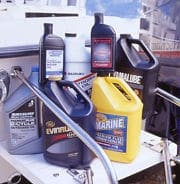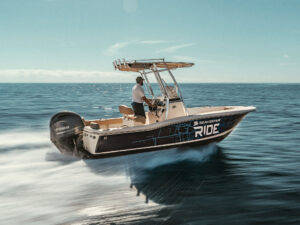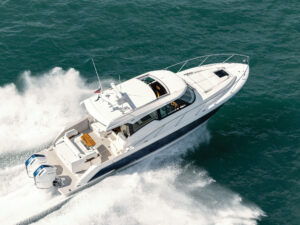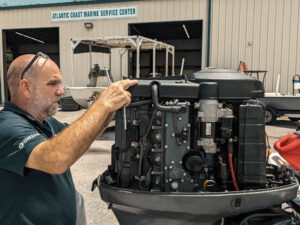
Despite the fact that the outboard-motor industry is leaning toward four-strokes as the technology of the future, the vast majority of outboards on the water today are two-strokes, and probably will be for many years. With all those two-strokes running around, the topic of two-stroke outboard oil inevitably comes up among fishermen. Dockside arguments ensue and spirited debates erupt on Internet forums over which marine oil is the right choice to protect that investment hanging on the transom. And what an investment it is! With outboard prices rising substantially in recent years, how best to maintain your engine is no small question.
The debate usually centers around whether one should use the oil sold by the engine manufacturer, or whether a less-expensive aftermarket oil will do an equally good job. As is everything else related to boats, oil prices have risen, and if you fish a lot, oil can be a significant part of your overall budget. Because aftermarket oils are often available through discount stores, they can be less expensive than the manufacturer’s brands, which are mostly sold through engine dealerships.
What is TC-W3 Oil?
Most current two-stroke outboard oils carry a TC-W3 rating. This rating is an industry certification, administered by the National Marine Manufacturers Association (NMMA), the people who operate the majority of boat shows around the country. The TC-W3 rating replaced the earlier TC-WII rating sometime in the early ’90s, but the ratings originated in the 1980s as lead was phased out of our gasolines.
The industry came up with a testing procedure to certify a basic and uniform level of lubrication and engine protection, and TC-W3 is the latest link in that evolution. The TC-W3 oils were specifically targeted toward piston-ring cleanliness, and the lubricity was substantially improved over what TC-WII oils had to offer.
Oils tested for certification by the NMMA must pass a series of grueling tests to receive the TC-W3 certification. The NMMA testing procedures are done using four engines: a 40-hp and a 70-hp Evinrude, a 15-hp Mercury and a 50-hp Yamaha. The oils are put through specific tests in each engine. For example, the 40-hp outboard is used to test ring stickage, while the 70-hp outboard is used to test for piston deposits. Each engine is examined for a different aspect of the oil’s performance.
If a 2 stroke marine oil meets or exceeds a certain set of criteria in each of the tests, it gets a TC-W3 rating, and the containers in which the oil is subsequently sold can carry a TC-W3 emblem signifying that the marine oil passed the tests. So is that all you need to know? Is simply buying a TC-W3 oil enough? It depends on who you ask.
Why They’re Different
We talked to several of the companies that sell two-stroke marine oil to find out what, if anything, differentiates their product from a basic TC-W3 blend. Almost all of them offer oils that go beyond the minimal standards of TC-W3 in protection, due to additives that increase lubricity and help keep the internal engine components clean.
Many current two-stroke outboard oils are built on a mid-viscosity base oil that would be considered around 20-weight. The base oil makes up approximately 60 percent of the final product. Then a heavier base oil called brightstock is added, normally at about five percent of the total, but sometimes as much as 17 percent. Brightstock is a great lubricity agent and helps make the oil more slippery.
Up to 20 percent of the final blend is solvent, which acts as a carrier and helps the oil mix thoroughly with gasoline (remember that there are still a lot of pre-mix engines in circulation). About one percent or less is dye, so you can tell if the pre-mix gas has oil in it. The remainder is made up of additives, which may or may not contain polyisobutylene, commonly known as PIB. PIB is a synthetic oil used for both lubrication and smoke control.
Additives Are Key
“All of the oils contain some amount of polyisobutylene, or PIB, as part of the additive package,” said Jeffery Hsu of Pennzoil-Quaker State. “It replaces some of the brightstock, which is good for lubricity, but bad for smoke. PIB burns very cleanly, but if you use too much it turns into gummy residue deposits in the combustion chambers.” Actually, it can be really gummy, similar in consistency to glue that has almost dried.
So making an outboard oil turns out to be a balancing act of mixing additives with base oils. Companies called “blenders” supply the base oil, and there are three companies in the U.S. that supply the additive packages for the different blends. However, the oil retailers vary widely in the formulations that go into their respective oils.
Jeff Hsu explained that Pennzoil-Quaker State offers a two-tiered product selection. “All of our oils are formulated above the bar,” he said. “Our Pennzoil Premium Outboard TC-W3 oil exceeds the basic TC-W3 standards, and our Pennzoil Marine Premium Plus brand goes beyond that by providing additional additives.”
Great, but what do all these additives do? “The base-oil technology is much less important than the additive technology,” said Steve Bethel, Mercury Marine’s Director of Advanced Product Engineering. “All of our oils exceed the ratings significantly. The two main improvements provided by additives are detergency and lubricity. And synergy between the additives is important. Sometimes additives will counteract one another, so Mercury works directly with the additive suppliers, plus we conduct extensive tests of our own to find the combination that is right for our products.”
Increased Engine Life
The other major engine manufacturers have similar philosophies. “When we put oil to the test, we’re looking at engine durability, not oil sales,” said Claude Von Plato, Yamaha’s Manager of Marine Parts and Accessories. He points out that Yamaha conducted extensive field tests on the Baja Peninsula before settling on the current formula for Yamalube.
The brightstock helps make the additive package more soluble and keep it active in the combustion chamber, letting the dispersants and the detergents stay together to clean the chamber more thoroughly. Dispersants help keep soot and varnish particles separated, so they don’t gather in the ring grooves. Detergents carry undesirable particulates, carbon mostly, out through the exhaust port. This can help reduce “coking,” the buildup of reside around the rings that can be fatal to a powerhead.
According to Dave Greenwood, Suzuki’s Quality Research and Testing Supervisor, Suzuki two-stroke oil is tested, not only to eliminate coking, but for anti-corrosion properties as well. “Automotive engines run hotter than outboards, and are therefore better at burning up moisture in the engine,” Greenwood explained. “But outboards live in such an extreme environment that it’s important to use oils formulated to the specific operating temperatures in your engines. We test and re-test our oil to engineer it specifically for our products.”
Most two-stroke engine oils are mineral-based, but you’re seeing more and more synthetics these days. Mercury’s Opti-Max oil is partially synthetic, for example, and Steve Bethel says there isn’t a standard in existence to challenge it. “Opti-Max oil is not TC-W3-rated, so far, because we haven’t ever submitted it for testing. It’s far beyond the TC-W3 standard.” Bethel says that the oil is partially synthetic because the synthetic component substantially drives the oil’s cost upward as it’s added, but there is a point of diminishing returns as to the benefit it provides. Once again, it’s a balancing act.
Bombardier markets a synthetic-blend oil containing CarbX combustion cleaner for use in its Evinrude Ficht Ram Injection outboards. “CarbX has a polarized molecular construction that seeks out carbon and holds it in suspension,” said Larry Koschak, Accessories Product Manager for Bombardier’s Evinrude and Johnson Genuine Parts. “Carbon treated with CarbX repels metal so it won’t stick to the piston and combustion chamber,” he said.
Nissan and Tohatsu also offer a synthetic blend. “We have a new synthetic oil blend that is specially formulated for use in our new TLDI (Two-Stroke Low Pressure Direct Injection) outboards,” said Garland Lewis, Service Manager of Nissan/Tohatsu’s parent company, Marubeni Engine and Power Corporation. “We are also recommending this new formula for use in our existing carbureted two-strokes. This superior-quality TC-W3 oil provides maximum protection, not only for the new-technology engines, but for conventional engines, as well, at an affordable price.”
Jeff Hsu sees the more expensive oils, with the additional additives, as a kind of insurance policy. “As a consumer, I tell myself, ‘I just paid $13,000 for that outboard, and I’m going to buy the oil with the most additives to protect it!’ But as a bargain shopper, I could argue that the industry does certify that basic TC-W3 oils meet all of their requirements, and by law engine manufacturers can’t require you to use only their oil. In America, we tend to think more is better, but it isn’t always so.”
As always, it comes down to a choice on your part. Go with the up-front savings and buy a less-expensive oil, hoping that it will provide adequate protection, or ante up for a pricier oil with all its additives, hoping that those additives really do provide additional protection. All of the oils that carry the TC-W3 credentials are good; you just have to decide if some are better than others.









